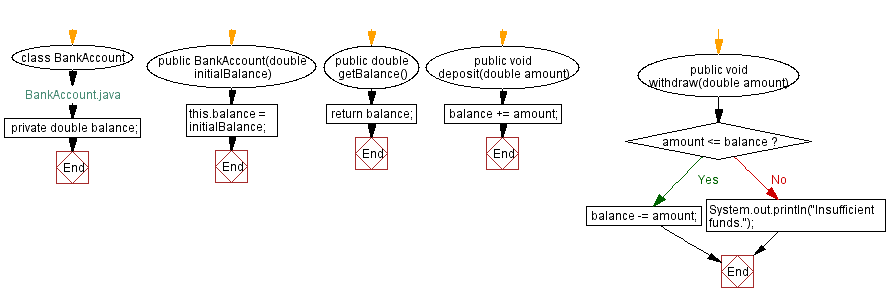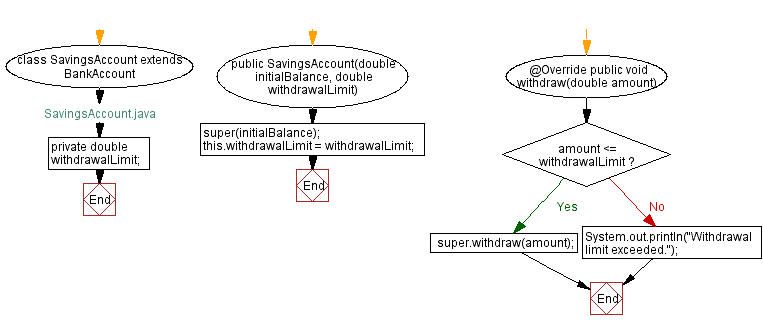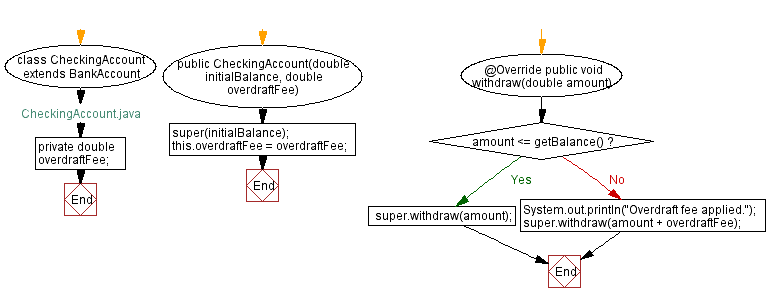Java Polymorphism: BankAccount base class with Savings, Checking Account subclasses
Write a Java program to create a base class BankAccount with methods deposit() and withdraw(). Create two subclasses SavingsAccount and CheckingAccount. Override the withdraw() method in each subclass to impose different withdrawal limits and fees.
Sample Solution:
Java Code:
// BankAccount.java
// Define a class named BankAccount
class BankAccount {
// Declare a private double variable balance
private double balance;
// Define a constructor that takes a double initialBalance as a parameter
public BankAccount(double initialBalance) {
// Assign the parameter initialBalance to the instance variable balance
this.balance = initialBalance;
}
// Define a method to get the current balance
public double getBalance() {
// Return the current balance
return balance;
}
// Define a method to deposit an amount to the balance
public void deposit(double amount) {
// Add the amount to the current balance
balance += amount;
}
// Define a method to withdraw an amount from the balance
public void withdraw(double amount) {
// Check if the amount to be withdrawn is less than or equal to the current balance
if (amount <= balance) {
// Subtract the amount from the current balance
balance -= amount;
} else {
// Print "Insufficient funds." to the console if the balance is insufficient
System.out.println("Insufficient funds.");
}
}
}
// SavingsAccount.java
// Define a class named SavingsAccount that extends BankAccount
class SavingsAccount extends BankAccount {
// Declare a private double variable withdrawalLimit
private double withdrawalLimit;
// Define a constructor that takes a double initialBalance and a double withdrawalLimit as parameters
public SavingsAccount(double initialBalance, double withdrawalLimit) {
// Call the constructor of the superclass BankAccount with initialBalance
super(initialBalance);
// Assign the parameter withdrawalLimit to the instance variable withdrawalLimit
this.withdrawalLimit = withdrawalLimit;
}
// Override the withdraw method from the BankAccount class
@Override
public void withdraw(double amount) {
// Check if the amount to be withdrawn is less than or equal to the withdrawal limit
if (amount <= withdrawalLimit) {
// Call the withdraw method of the superclass BankAccount with amount
super.withdraw(amount);
} else {
// Print "Withdrawal limit exceeded." to the console if the amount exceeds the withdrawal limit
System.out.println("Withdrawal limit exceeded.");
}
}
}
// CheckingAccount.java
// Define a class named CheckingAccount that extends BankAccount
class CheckingAccount extends BankAccount {
// Declare a private double variable overdraftFee
private double overdraftFee;
// Define a constructor that takes a double initialBalance and a double overdraftFee as parameters
public CheckingAccount(double initialBalance, double overdraftFee) {
// Call the constructor of the superclass BankAccount with initialBalance
super(initialBalance);
// Assign the parameter overdraftFee to the instance variable overdraftFee
this.overdraftFee = overdraftFee;
}
// Override the withdraw method from the BankAccount class
@Override
public void withdraw(double amount) {
// Check if the amount to be withdrawn is less than or equal to the current balance
if (amount <= getBalance()) {
// Call the withdraw method of the superclass BankAccount with amount
super.withdraw(amount);
} else {
// Print "Overdraft fee applied." to the console if the amount exceeds the current balance
System.out.println("Overdraft fee applied.");
// Call the withdraw method of the superclass BankAccount with the amount plus the overdraft fee
super.withdraw(amount + overdraftFee);
}
}
}
// Main.java
// Main class definition
public class Main {
// Main method, program entry point
public static void main(String[] args) {
// Create a SavingsAccount object with a balance of 2000 and a limit of 650
BankAccount savingsAccount = new SavingsAccount(2000, 650);
// Create a CheckingAccount object with a balance of 1000 and a limit of 100
BankAccount checkingAccount = new CheckingAccount(1000, 100);
// Withdraw 300 from the savings account
withdrawFromAccount(savingsAccount, 300);
// Withdraw 250 from the checking account
withdrawFromAccount(checkingAccount, 250);
// Print the current balance of the savings account
System.out.println("Savings Account Balance: " + savingsAccount.getBalance());
// Print the current balance of the checking account
System.out.println("Checking Account Balance: " + checkingAccount.getBalance());
}
// Method to withdraw a specified amount from a given bank account
public static void withdrawFromAccount(BankAccount account, double amount) {
// Call the withdraw method on the account with the specified amount
account.withdraw(amount);
}
}
Output:
Savings Account Balance: 1700.0 Checking Account Balance: 750.0
Explanation:
In the above exercise -
- The "BankAccount" class is the base class, and SavingsAccount and CheckingAccount are its subclasses. Each subclass overrides the withdraw() method to impose different withdrawal limits and fees based on their specific rules.
- In the "Main" class, we have a static method withdrawFromAccount(BankAccount account, double amount) that takes an object of the base class BankAccount as a parameter. Inside this method, we call the withdraw() method on the account object. Since the withdrawFromAccount method takes a BankAccount type parameter, it can accept SavingsAccount and CheckingAccount objects, thanks to polymorphism.
Flowchart:




For more Practice: Solve these Related Problems:
- Write a Java program where the "BankAccount" class supports overdraft protection for CheckingAccount.
- Write a Java program where the "BankAccount" class includes a method to transfer money between accounts.
- Write a Java program where the "BankAccount" class tracks transaction history.
- Write a Java program where the "BankAccount" class applies a service fee for withdrawals.
Go to:
Java Code Editor:
Contribute your code and comments through Disqus.
PREV : Shape base class with Circle, Square, and Triangle subclasses.
NEXT : Animal base class with Lion, Tiger, and Panther subclasses.
What is the difficulty level of this exercise?
